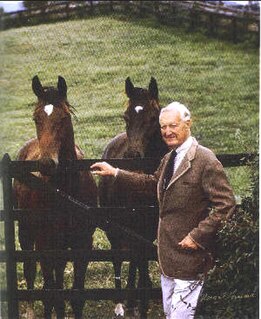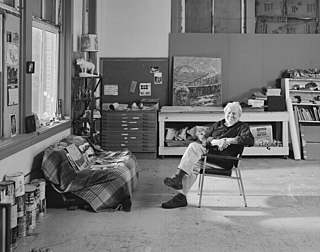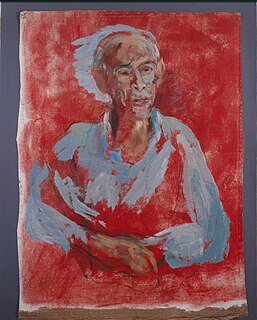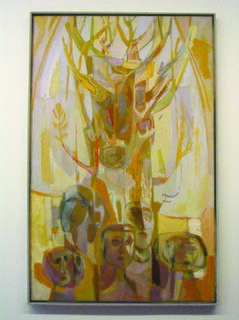Related Research Articles

Paul Mellon was an American philanthropist and an owner/breeder of thoroughbred racehorses. He is one of only five people ever designated an "Exemplar of Racing" by the National Museum of Racing and Hall of Fame. He was co-heir to one of America's greatest business fortunes, derived from the Mellon Bank created by his grandfather Thomas Mellon, his father Andrew W. Mellon, and his father's brother Richard B. Mellon. In 1957, when Fortune prepared its first list of the wealthiest Americans, it estimated that Paul Mellon, his sister Ailsa Mellon-Bruce, and his cousins Sarah Mellon and Richard King Mellon, were all among the richest eight people in the United States, with fortunes of between 400 and 700 million dollars each.
Brice Marden is an American artist generally described as Minimalist, although his work may be hard to categorize. He lives and works in New York City; Tivoli, New York; Hydra, Greece; and Eagles Mere, Pennsylvania.
Philip Pearlstein is an American painter best known for Modernist Realism nudes. Cited by critics as the preeminent figure painter of the 1960s to 2000s, he led a revival in realist art. He is a Distinguished Professor Emeritus with paintings in the collections of over 70 public art museums.
Deborah Kass is an American artist whose work explores the intersection of pop culture, art history, and the construction of self. Deborah Kass works in mixed media, and is most recognized for her paintings, prints, photography, sculptures and neon lighting installations. Kass's early work mimics and reworks signature styles of iconic male artists of the 20th century including Frank Stella, Andy Warhol, Jackson Pollock, and Ed Ruscha. Kass's technique of appropriation is a critical commentary on the intersection of social power relations, identity politics, and the historically dominant position of male artists in the art world.
Matt Wrbican (1959–2019) was an American archivist and authority on the life of the artist Andy Warhol. He earned his BFA in Painting and MFA in Intermedia/Electronic Art from Carnegie Mellon University (CMU), where he studied with Bruce Breland. He began working with the Warhol Archive in 1991 in New York City and became Chief Archivist of The Andy Warhol Museum in Pittsburgh, Pennsylvania, United States. He managed the Archive and Warhol's Time Capsules for more than two decades at the Warhol Museum, where he unpacked, processed, preserved, and documented an estimated 500,000 objects. His last book is A is for Archive: Warhol's World from A to Z. He also exhibited his artwork at the Pittsburgh Center for the Arts and Galleries. He died on Saturday, June 1, 2019, after a four-year battle with brain cancer.

The Miller ICA at Carnegie Mellon University is the contemporary art gallery of Carnegie Mellon University in Pittsburgh, Pennsylvania.
Elaine A. King is a curator, critic, professor, and editor.

Balcomb Greene (1904–1990) was an American artist and teacher. He and his wife, artist Gertrude Glass Greene, were heavily involved in political activism to promote mainstream acceptance of abstract art and were founding members of the American Abstract Artists organization. His early style was completely non-objective. Juan Gris and Piet Mondrian as well as Pablo Picasso and Henri Matisse influenced his early style. From the 1940s his work "opened out to the light and space of natural form." He painted landscapes and figure. "He discerned the pain of a man, and hewed to it integrally from beginning to end…. In his study of the figure he did not stress anatomical shape but rather its intuitive, often conflicting spirit."

Leopold Gould Seyffert was an American artist. Born in California, Missouri and raised as a child in Colorado and then Pittsburgh, his career brought him eventually to New York City, via Philadelphia and Chicago. In New York the dealer Macbeth established him as one of the leading portraitists of the 20th century and his over 500 portraits continue to decorate the galleries, rooms and halls of many of America's museums and institutions.
George Earl Ortman was an American painter, printmaker, constructionist and sculptor. His work has been referred to as Neo-Dada, pop art, minimalism and hard-edge painting. His constructions, built with a variety of materials and objects, deal with the exploration off visual language derived from geometry—geometry as symbol and sign.

Stephen Greene was an American artist known for his abstract paintings and in the 1940s his social realist figure paintings.

Robert L. Qualters, Jr. is an American painter, installation artist and printmaker based in Pittsburgh, Pennsylvania. His work encompasses traditional painting, as well as murals, and collaborations with other Pittsburgh-based artists across several disciplines. He is associated with the Bay Area Figurative Movement of Representational Painting.
Henry Koerner was an Austrian-born American painter and graphic designer best known for his early Magical Realist works of the late 1940s and his portrait covers for Time magazine.

Robert Lepper (1906-1991) was an American artist and art professor at Carnegie Institute of Technology, now Carnegie Mellon University, who developed the country's first industrial design degree program. Lepper's work in industrial design, his fascination with the impact of technology on society and its potential role for artmaking formed the background for his class "Individual and Social Analysis", a two semester class focusing on community and personal memory as factors in artistic expression, which with his theoretical dialogues with his most promising students outside the classroom fostered the intellectual environment from which such diverse artists as Andy Warhol, Philip Pearlstein, Mel Bochner, and Jonathan Borofsky would later build their art practices.

Kraus Campo is a roof garden and landscape design space in Pittsburgh, Pennsylvania. It is located on the roof of the Posner Center on the Carnegie Mellon University campus, between the College of Fine Arts building and Posner Hall. The Campo was designed and created by artist Mel Bochner and landscape architect Michael Van Valkenburgh. The Campo consists of orange pathways surrounded by various species of shrubs, a central seating area, and a quotation tiled onto the back wall. It was commissioned by and named after Jill Gansman Kraus, a university trustee, and her husband Peter Kraus.

Norman L. Kleeblatt is a curator, critic, and consultant based in New York City. A long-term curator at the Jewish Museum in New York, he served as the Susan and Elihu Rose Chief Curator from 2005 to 2017.
Matt Keegan is a visual artist working across disciplines including sculpture, photography, printmaking, video, and independent publishing. Keegan's work is conceptual and multi-faceted, and it often involves the intersection of language and image, as well as collaboration. He lives and works in Brooklyn, NY.
Samuel Rosenberg (1896–1972) was an American artist and Professor at Carnegie Mellon University in Pittsburgh, PA. He showed his work at the Museum of Modern Art, the Whitney Museum in New York, the National Academy of Art in Washington, the Corcoran Gallery, and in the Pennsylvania Academy of Fine Arts. He was a beloved art teacher, and some of his students were Mel Bochner, Philip Pearlstein and Andy Warhol.
Blah! Blah! Blah! is series of word paintings executed by the American conceptual artist and painter Mel Bochner between 2008 and 2012, featuring various chromatic and placement variations on the words and in concert the phrase "Blah! Blah! Blah!".

Nathaniel J. Jacobson (1916–1996) was an American artist, educator and color theorist based in Boston. He began his studies Museum of Fine Arts School, followed by the Massachusetts School of Art. After graduating in 1938, Jacobson enrolled in Yale University's School of the Fine Arts, receiving his BFA in 1941. Jacobson enlisted in the army in 1943 and after serving, the themes of his paintings turned towards his experience in Europe during World War II.
References
- ↑ Yale faculty profile
- ↑ Mel Bochner interview with Phong Bui
- ↑ the algemeiner/Aug 2014 "As an American Jew, I see these words and realize how much Jewish culture has become a part of every-day American life."
- ↑ Yale faculty profile
- ↑ Russell, John (17 November 1985). "ART VIEW; THE BEST AND BIGGEST IN PITTSBURGH". New York Times . Retrieved 1 February 2013.
- ↑ Philip Kennicott (November 4, 2011). "Critic's review: National Gallery's 'In the Tower: Mel Bochner'". The Washington Post.
- ↑ "Mel Bochner Whitechapel Exhibition 2012" . Retrieved 4 October 2012.
- ↑ "Mel Bochner Monograph" . Retrieved 4 October 2012.
- ↑ Lakin, Max (26 November 2019). "A Conceptual Art Pioneer Who Doesn't Mince Words". The New York Times.